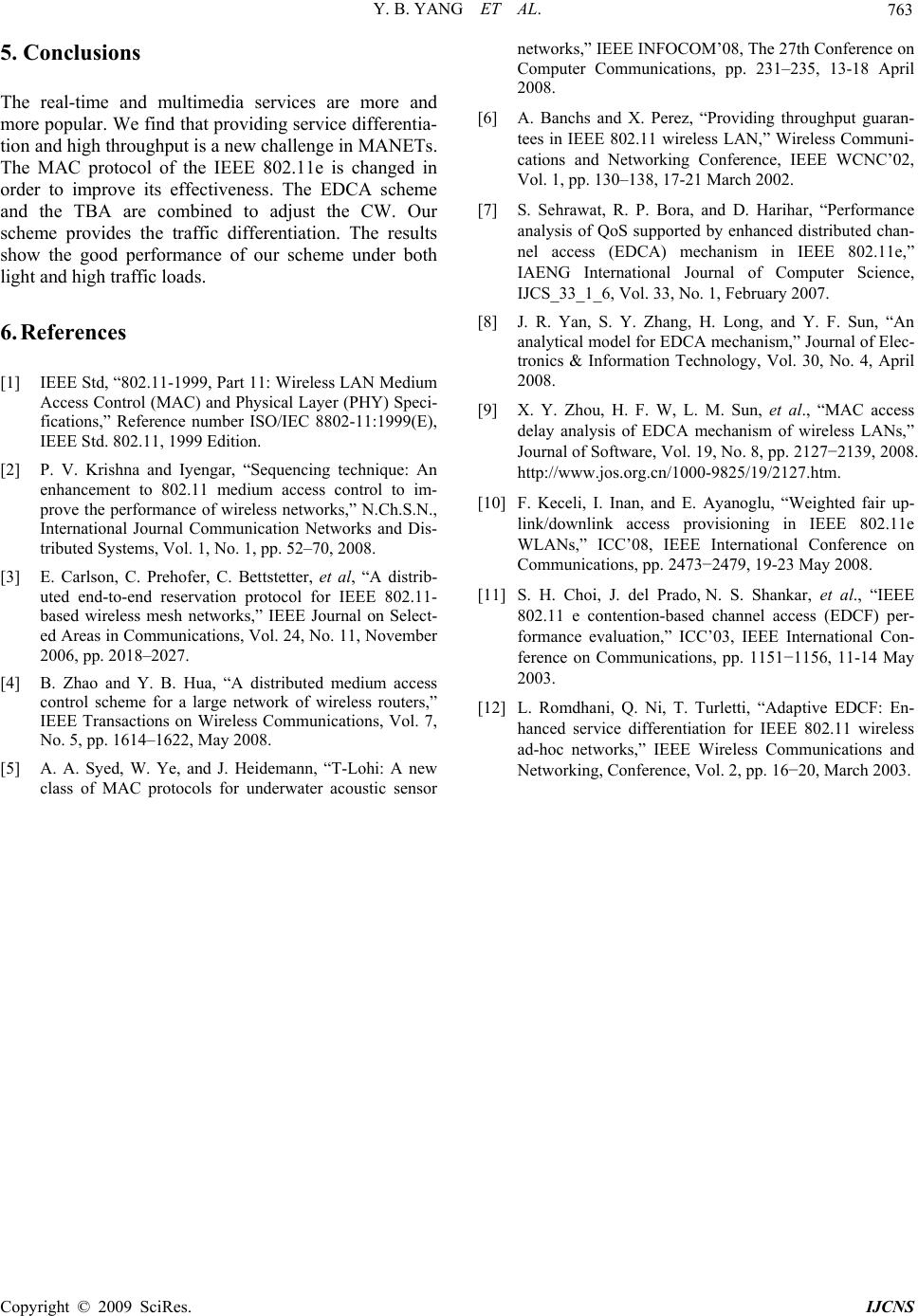
Y. B. YANG ET AL. 763
5. Conclusions
The real-time and multimedia services are more and
more popular. We find that providing service differentia-
tion and high throughput is a new challenge in MANETs.
The MAC protocol of the IEEE 802.11e is changed in
order to improve its effectiveness. The EDCA scheme
and the TBA are combined to adjust the CW. Our
scheme provides the traffic differentiation. The results
show the good performance of our scheme under both
light and high traffic loads.
6. References
[1] IEEE Std, “802.11-1999, Part 11: Wireless LAN Medium
Access Control (MAC) and Physical Layer (PHY) Speci-
fications,” Reference number ISO/IEC 8802-11:1999(E),
IEEE Std. 802.11, 1999 Edition.
[2] P. V. Krishna and Iyengar, “Sequencing technique: An
enhancement to 802.11 medium access control to im-
prove the performance of wireless networks,” N.Ch.S.N.,
International Journal Communication Networks and Dis-
tributed Systems, Vol. 1, No. 1, pp. 52–70, 2008.
[3] E. Carlson, C. Prehofer, C. Bettstetter, et al, “A distrib-
uted end-to-end reservation protocol for IEEE 802.11-
based wireless mesh networks,” IEEE Journal on Select-
ed Areas in Communications, Vol. 24, No. 11, November
2006, pp. 2018–2027.
[4] B. Zhao and Y. B. Hua, “A distributed medium access
control scheme for a large network of wireless routers,”
IEEE Transactions on Wireless Communications, Vol. 7,
No. 5, pp. 1614–1622, May 2008.
[5] A. A. Syed, W. Ye, and J. Heidemann, “T-Lohi: A new
class of MAC protocols for underwater acoustic sensor
networks,” IEEE INFOCOM’08, The 27th Conference on
Computer Communications, pp. 231–235, 13-18 April
2008.
[6] A. Banchs and X. Perez, “Providing throughput guaran-
tees in IEEE 802.11 wireless LAN,” Wireless Communi-
cations and Networking Conference, IEEE WCNC’02,
Vol. 1, pp. 130–138, 17-21 March 2002.
[7] S. Sehrawat, R. P. Bora, and D. Harihar, “Performance
analysis of QoS supported by enhanced distributed chan-
nel access (EDCA) mechanism in IEEE 802.11e,”
IAENG International Journal of Computer Science,
IJCS_33_1_6, Vol. 33, No. 1, February 2007.
[8] J. R. Yan, S. Y. Zhang, H. Long, and Y. F. Sun, “An
analytical model for EDCA mechanism,” Journal of Elec-
tronics & Information Technology, Vol. 30, No. 4, April
2008.
[9] X. Y. Zhou, H. F. W, L. M. Sun, et al., “MAC access
delay analysis of EDCA mechanism of wireless LANs,”
Journal of Software, Vol. 19, No. 8, pp. 2127−2139, 2008.
http://www.jos.org.cn/1000-9825/19/2127.htm.
[10] F. Keceli, I. Inan, and E. Ayanoglu, “Weighted fair up-
link/downlink access provisioning in IEEE 802.11e
WLANs,” ICC’08, IEEE International Conference on
Communications, pp. 2473−2479, 19-23 May 2008.
[11] S. H. Choi, J. del Prado, N. S. Shankar, et al., “IEEE
802.11 e contention-based channel access (EDCF) per-
formance evaluation,” ICC’03, IEEE International Con-
ference on Communications, pp. 1151−1156, 11-14 May
2003.
[12] L. Romdhani, Q. Ni, T. Turletti, “Adaptive EDCF: En-
hanced service differentiation for IEEE 802.11 wireless
ad-hoc networks,” IEEE Wireless Communications and
Networking, Conference, Vol. 2, pp. 16−20, March 2003.
C
opyright © 2009 SciRes. IJCNS